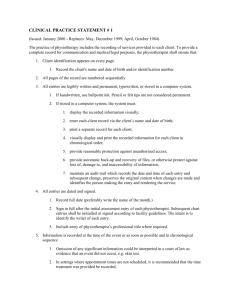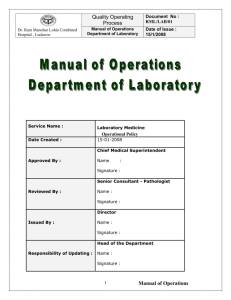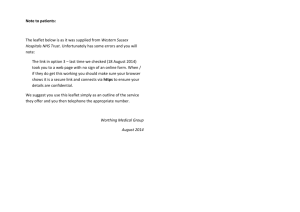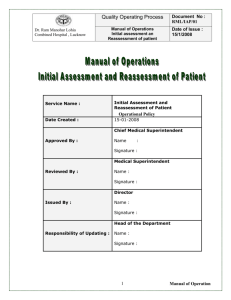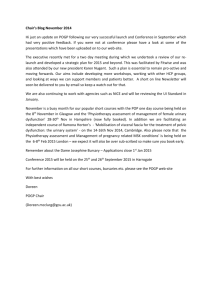Physiotherapy Department Manual of Operations
advertisement
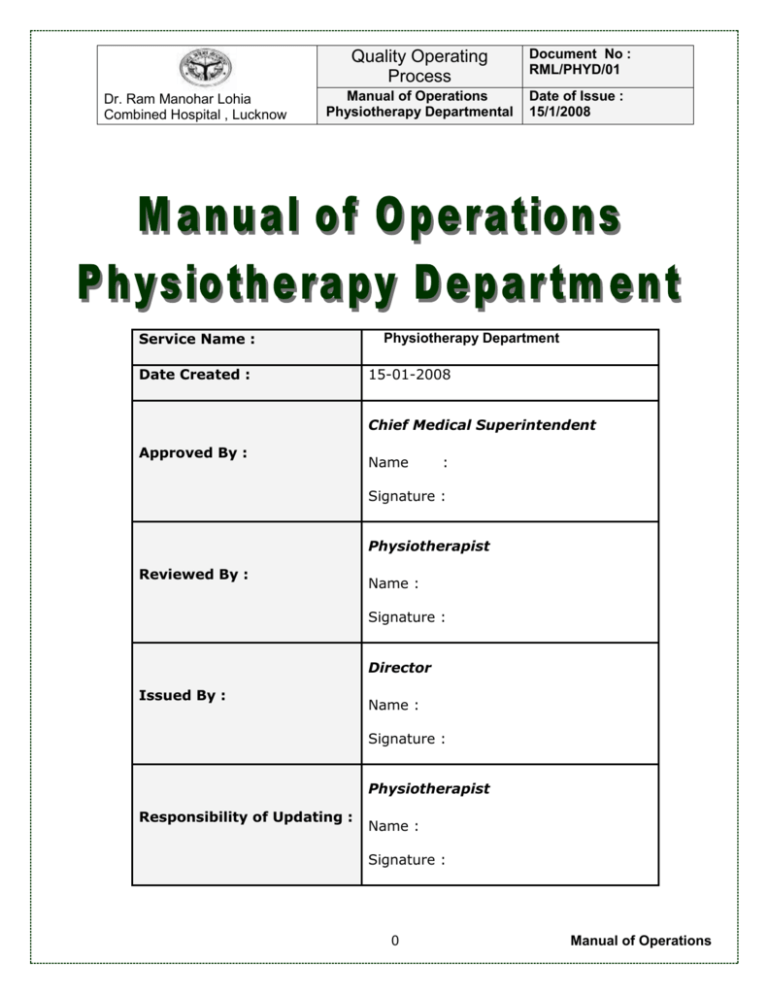
Dr. Ram Manohar Lohia Combined Hospital , Lucknow Quality Operating Process Document No : RML/PHYD/01 Manual of Operations Physiotherapy Departmental Date of Issue : 15/1/2008 Service Name : Date Created : Physiotherapy Department 15-01-2008 Chief Medical Superintendent Approved By : Name : Signature : Physiotherapist Reviewed By : Name : Signature : Director Issued By : Name : Signature : Physiotherapist Responsibility of Updating : Name : Signature : 0 Manual of Operations Dr. Ram Manohar Lohia Combined Hospital , Lucknow Quality Operating Process Document No : RML/PHYD/01 Manual of Operations Physiotherapy Departmental Date of Issue : 15/1/2008 Page of contents Sl.Order Particulars A Purpose B Scope C Definitions and Abbreviations D Inpatient Work Process E Outpatient Work Process F Treatment Modalities 1.Interferential Therapy 2.Ultrasound Therapy 3.Parafin Wax Bath 4.Moist Heat Therapy 5.Short Wave Diathermy 6.Traction 7.Electric Stimulation 8.Continuous Passive Motion 9.Exercise Therapy 10.Pulmonary Function Test G Departmental Policy H Patient Safety I Maintenance of Patients Confidentiality J Maintenance of Equipment 1 Manual of Operations Dr. Ram Manohar Lohia Combined Hospital , Lucknow A. Quality Operating Process Document No : RML/PHYD/01 Manual of Operations Physiotherapy Departmental Date of Issue : 15/1/2008 Purpose: The purpose of the Physiotherapy Department is to provide an expert physiotherapy service, with systematic methods of assessing musculo-skeletal, cardio-vascular, etc disorders of function including pain and those of a psychosomatic origin and dealing with or preventing these problems by natural methods based essentially on movement, manual therapy and physical agencies. B. Scope : Include staff and patients involved in the process. C. Definitions and Abbreviations: 1.Postural Drainage Positioning the patient according to the anatomy of the bronchial tree in order to use gravity to assist drainage of secretions. 2.Gait Training Gait training begins by teaching transfers to the bed, mat and wheel chair, then improving standing balance on the affected limb. The patient is taught the most optimal gait pattern in and out of the parallel bars, and on stairs, ramps, and curbs. Orthosis (braces) and other assistive devices are used to correct gait deviations, and may decrease energy expenditure during gait. Harnesses to provide partial body weight support may accelerate early ambulation. 3.Vertigo Vertigo, or dizziness, is a symptom, not a disease. The term vertigo refers to the sensation of spinning or whirling that occurs as a result of a disturbance in balance (equilibrium). It also may be used to describe feelings of dizziness, faintness, and unsteadiness vertigo usually occurs as a result of a disorder in the vestibular system (i.e., structures of the inner ear, the vestibular nerve, brainstem, and cerebellum). The vestibular system is responsible for integrating sensory stimuli and movement and for objects in visual focus as the body moves. 2 Manual of Operations Dr. Ram Manohar Lohia Combined Hospital , Lucknow 4. Quality Operating Process Document No : RML/PHYD/01 Manual of Operations Physiotherapy Departmental Date of Issue : 15/1/2008 Abbreviations ABBREVIATIONS IFT UST SWD CVT LBT WXT MOT LAS CPM PD GAT PSN MBZ CPT SPN PVF PFT ROM Mm FULL FORM Interferential therapy Ultrasound therapy Shortwave diathermy Cervical traction Lumbar traction Wax therapy Moist therapy Laser therapy Continuous passive movement Postural drainage Gait training Post natal exercise Mobilization exercise Chest physiotherapy Spinal exercise Pelvic floor exercise Pulmonary function test Range of motion Muscle power 3 Manual of Operations Dr. Ram Manohar Lohia Combined Hospital , Lucknow Quality Operating Process Document No : RML/PHYD/01 Manual of Operations Physiotherapy Departmental Date of Issue : 15/1/2008 D. Inpatient Work Process: Patient in ward Doctor refers patient for physiotherapy treatment Nurse informs physiotherapist & send request form to physio dept Assessment and evaluation of the patient Physio treatment starts Entry Made in Patients’ BST Order entry 4 Manual of Operations Dr. Ram Manohar Lohia Combined Hospital , Lucknow Quality Operating Process Document No : RML/PHYD/01 Manual of Operations Physiotherapy Departmental Date of Issue : 15/1/2008 E. Out patient work process : e Consultant refers to Physiotherapy department Patient with reference enters the physiotherapy department Patient assessment and evaluation done Plan of treatment and treatment starts Appointment given Entry made in Patient’s case sheet Patient leaves the department 5 Manual of Operations Dr. Ram Manohar Lohia Combined Hospital , Lucknow F. Quality Operating Process Document No : RML/PHYD/01 Manual of Operations Physiotherapy Departmental Date of Issue : 15/1/2008 Treatment modalities 1. Interferential Therapy : Procedure: It is a method of producing Low frequency current selectively at any tissue depth without the problem of skin resistance a. Preparation of patients: i. Position the patient comfortably with the area to be treated adequately supported, exposed and relaxed. ii. Inspect the part of any cuts, abrasions, excessive swelling, warmth or any skin condition. iii. Inform the patient about the treatment and sensation to be experienced – a mild pricking sensation but pleasant. b. Treatment: i. Explain the procedure to the patient ii. Apply the electrodes firmly on the patient’s complaint area iii. Make sure sponges are adequately damped iv. Position the electrodes so that the red and black leads are diagonally across v. Turn on the equipment, select the programme, frequency, and increase the intensity up to the patient tolerance vi. Duration of the Treatment – between 10 – 15 minutes, based on level Acute Sub acute Chronic c. Precautions: i. Patient should not feel the heat, burning sensation, discomfort, or pinching sensation beneath the electrode ii. Do not apply electrodes over mucous membranes iii. Patient should remove all kind of jewels before treatment. 6 Manual of Operations Dr. Ram Manohar Lohia Combined Hospital , Lucknow Quality Operating Process Document No : RML/PHYD/01 Manual of Operations Physiotherapy Departmental Date of Issue : 15/1/2008 d. Infection control: i. Cleaning the electrode pads with water before and after the treatment. ii. Electrode pads must be cleaned with alcohol swabs in infectious patients 2.Ultrasound Therapy: Procedure: Ultrasound is high frequency sound waves that produce temperature elevation to the deeper structures with out causing excessive heating of the superficial layers through the use of coupling agents a. Preparation of the Patient: i. Position the patient comfortably with the area to be treated adequately supported, exposed and relaxed. ii. Inspect the part for any cuts, abrasions, excessive swelling, warmth or any skin condition iii. Inform the patient about the treatment and sensation to be experienced – a mild heat b. Treatment: i. Explain the procedure ii. Apply generous amount of coupling agent. Spread the gel evenly over the transducer iii. Slowly increase the intensity apply the transducer to the skin and move continuously in small circular motions iv. Duration of the Treatment is between 10 – 15 minutes, based on levels Acute Sub acute Chronic c. Precautions: i. Keep the transducer head moving continuously on the skin or burning may occur through over heating of tissues ii. Do not hold the transducer head in the air or break treatment contact, this could damage the transducer head crystals 7 Manual of Operations Dr. Ram Manohar Lohia Combined Hospital , Lucknow Quality Operating Process Document No : RML/PHYD/01 Manual of Operations Physiotherapy Departmental Date of Issue : 15/1/2008 iii. Do not treat near the heart iv. Not to be used during pregnancy v. Patients with the Pace maker should not be in the treatment area/ undergo treatment. d. Infection control: i. Clean the transducer head with tissue paper after every use ii. Transducer head must be cleaned with the alcohol swabs in infectious patients 3.Paraffin Wax Bath : Procedure: Paraffin wax bath is utilization of paraffin wax at a temperature 40- 44 degree Celsius. The application of hot wax through dipping with the lint cloth and apply to patient’s extremities .This wax has low thermal conductivity, so that the heat will stay in the tissues for a longer period. a. Preparation of the patient: i. Position the patient comfortably with the area to be treated adequately supported, exposed and relaxed. ii. The part to be treated must be cleaned and free form cuts, rashes or infections iii. Inform the patient about the treatment and sensation to be experienced – a mild heat b. Treatment: i. Explain the procedure ii. Therapist should wear gloves iii. Dip the lint clothe in the wax bath, clear the excess wax on the cloth and wrap it around the area to be treated iv. Duration of the treatment 20 – 30minutes c. Precautions: i. Patient should be cautioned not to change position during treatment ii. Paraffin can easily fall to the floor during treatment making the floor slippery iii. Paraffin wax is flammable . 8 Manual of Operations Dr. Ram Manohar Lohia Combined Hospital , Lucknow Quality Operating Process Document No : RML/PHYD/01 Manual of Operations Physiotherapy Departmental Date of Issue : 15/1/2008 d. Infection control: i. Change the lint cloth once a week ii. Wax bath to be cleaned with the spirit when the wax is replaced with new (once in four months) iii. Lint cloth has to be discarded if used in infectious patient 4.Moist Heat Therapy: Procedure: Silicon hot packs are conductive type of superficial moist heat. The temperature has to be maintained between 70 – 100 degrees Celsius a. Preparation of the patient: i. Drape the patient, expose the area to be treated, place the patient in comfortable position ii. The part to be treated must be cleaned and free form cuts, rashes or infections iii. Inform the patient about the treatment and sensation to be experienced – a mild heat b. Treatment: i. Explain the procedure to the patient ii. Place the towel between the patient’s skin or treatment area and the hot packs iii. Wrap additional towels depending on patient’s tolerance to heat iv. Duration of the treatment is 20 – 30 minutes c. Precautions: i. Extra towel must be utilized, so heat is not transferred too quickly and results in burn. 9 Manual of Operations Dr. Ram Manohar Lohia Combined Hospital , Lucknow Quality Operating Process Document No : RML/PHYD/01 Manual of Operations Physiotherapy Departmental Date of Issue : 15/1/2008 5. Short Wave Diathermy : Procedure: 1. High frequency current produced deep heat with in body tissues for therapeutic purposes. Produces heat below the skin surfaces through conversion heat transmission. a. Preparation of the patient: i. Drape the patient, expose the area to be treated, place the patient in comfortable position. ii. The part to be treated must be cleaned and free form cuts, rashes or infections iii. Inform the patient about the treatment and sensation to be experienced – a Deep heat b. Treatment: i. Explain the procedure to the patient ii. Place one layer of the towel over the treatment area. iii. Position the treatment area midway between two electrodes iv. Allow the machine to warm up first two minutes v. Increase the intensity until the patient feels a soothing sensation vi. Give the patient the call bell in case the heat is more. vii. Duration of the treatment 15 – 30 minutes c. Precautions: i. Patients with the Pace maker should not be in the treatment area ii. Patient should not move during treatment or touch cable or the machine iii. Due to electromagnetic radiation all watch, jewellery and hearing aids should be removed d. Infection control: i. Change the towel used for disc and pads everyday 10 Manual of Operations Dr. Ram Manohar Lohia Combined Hospital , Lucknow Quality Operating Process Document No : RML/PHYD/01 Manual of Operations Physiotherapy Departmental Date of Issue : 15/1/2008 6. Traction: Procedure: 1. Mechanical traction applies a distraction force to the spine to attempt to separate vertebral bodies and elongate spinal structures. a. Preparation of the patient: i. Check the weight of the patient ii. Patient is positioned supine on the table with belt underneath iii. Inform the patient about the treatment and pull to be experienced b. Treatment: i. Explain the procedure to the patient ii. Set the tension according to the patient’s body weight iii. See that the belt around the patient is secured iv. Adjust the traction machine height for correct pull alignment v. Have an emergency shut off device available to the patient vi. Duration of the treatment is 15 – 20 minutes c. Precautions: i. Do not move during the treatment ii. Use the emergency shut off device if needed iii. Traction not advised during osteoporosis, pregnancy, bone tumors, spinal infection and fractures d. Infection control i. Wrap a tissue paper on the cervical head halter for every treatment. 11 Manual of Operations Dr. Ram Manohar Lohia Combined Hospital , Lucknow Quality Operating Process Document No : RML/PHYD/01 Manual of Operations Physiotherapy Departmental Date of Issue : 15/1/2008 7. Electric Stimulation: Procedure: Electrical stimulation is the use of electricity to stimulate nerves and muscles. It is used to accomplished a variety of therapeutic purposes, such as effect on de innervated muscles, innervated muscle and decreased spasm a. Preparation of the patient: i. The part to be treated must be cleaned and free form cuts, rashes or infections ii. Inform the patient about the treatment and sensation to be experienced – mild pricking sensation b. Treatment: i. Explain the procedure to the patient ii. Place the dispersive electrode on an antagonistic muscle surface and active electrode over area being treated iii. Set the intensity based on the muscle contraction iv. Duration of the treatment 10 – 20 minutes c. Precautions: i. Use correct type of current for de innervated and innervated muscles ii. Equipment should be over mackintosh sheet iii. Make sure the intensity knob to be turned to zero prior to turning on the machine d. Infection control: i. Use a new cotton padding for every treatment. 12 Manual of Operations Dr. Ram Manohar Lohia Combined Hospital , Lucknow Quality Operating Process Document No : RML/PHYD/01 Manual of Operations Physiotherapy Departmental Date of Issue : 15/1/2008 8. Continuous Passive motion : Procedure: The passive movement of lower extremities through a predetermined range of motion by the use of a mechanical device. a. Preparation of the patient: i. The part to be treated must be covered with a dressing to maintain sterile conditions ii. Inform the patient about the treatment and movement in the knee within pain free range. b. Treatment: i. Explain the procedure to the patient ii. Adjust the unit under the patient with the anatomical joint aligning with the mechanical hinge joint on the machine. iii. Place joint in the machine and secure safety straps iv. Set the beginning and end range of motion degrees on the machine. v. Turn the unit on and monitor for security of treatment area, joint placement, and patient complaints vi. Provide the patient with an emergency shut off switch in case of any discomfort c. Precautions: i. For safety of the patient, be sure to remove all linen and clothing away from roller tracks ii. Make sure the setting knob to be turned to zero prior to turning on the machine d. Infection control: i. Clean the equipment with spirit once a week 13 Manual of Operations Dr. Ram Manohar Lohia Combined Hospital , Lucknow Quality Operating Process Document No : RML/PHYD/01 Manual of Operations Physiotherapy Departmental Date of Issue : 15/1/2008 9. Exercise Therapy : Procedure: Exercise is physical activity in order to improve one’s health. Physicians, and physical therapist, have found that exercise plays an important role in the maintenance of brain, nerve and muscle function in the human body. Therapeutic exercises have been designed to enhance a variety of aspects of physical fitness in patients suffering from diseases and dysfunctions. New research suggests that exercise may delay mental deterioration with age and disease. a. Goals of Exercise therapy i. To improve blood circulation ii. To improve co-ordination iii. Maintain balance iv. To increase muscle power v. Joint mobility vi. To improve flexibility vii. To strengthen the muscles viii. To increase respiratory capacity b. Preparation of the patient: i. Positioning the patient ii. Explanation and demonstration of the exercise c. Various types of exercise are i. Active exercise ii. Active Assistive exercise iii. Resistive exercise iv. Passive exercise v. Mobilization vi. Independence in mobility vii. Spinal exercise viii. Respiratory exercise 14 Manual of Operations Dr. Ram Manohar Lohia Combined Hospital , Lucknow Quality Operating Process Document No : RML/PHYD/01 Manual of Operations Physiotherapy Departmental Date of Issue : 15/1/2008 ix. Strengthening exercise x. Co-ordination exercise xi. Vertigo exercise xii. Mat exercise xiii. Postural drainage xiv. Massage xv. Chest manipulation xvi. Diabetic exercise xvii. Antenatal exercise xviii. Post natal exercise xix. Pre operative exercise xx. Post operative exercise xxi. Pelvic floor exercise xxii. Ambulation exercise 10.Pulmonary Function Test: Pulmonary function test is performed to assess the functional states of the lungs. It measures how well the lungs take in and exhale air and how efficiently they transfer oxygen into the blood. a. Procedure: In a pulmonary function test or spirometry test, a person breathes into mouthpiece that is connected to an instrument called a spiro meter. The spiro meter records the amount and the rate of air that is breathed in and out over a specified time. Some of the test measurements are obtained by normal, quiet breathing and other tests require forced inhalation or exhalation after a deep breath.It is designed to measure changes in volume and can only measure lung volume compartments that exchange gas with the atmosphere. Spiro meters with electronic signal outputs also measure flow (volume per unit of time). A device is usually always attached to the spiro meter which measures the movement of gas in and out of the chest and is referred to as a spiro graph. Sometimes the spiro graph is 15 Manual of Operations Dr. Ram Manohar Lohia Combined Hospital , Lucknow Quality Operating Process Document No : RML/PHYD/01 Manual of Operations Physiotherapy Departmental Date of Issue : 15/1/2008 replaced by a printer. The resulting tracing is called a spiro gram. Many computerized systems have complex Spiro graphs or printouts that show the predicted values next to the observed values (the values actually measured). The unit will have in memory all of the prediction tables for males and females across all age groups. b. Precautions: i. Do not eat a heavy meal before the test ii. Do not smoke for 4 – 6 hours prior to the test iii. Do not exercise strenuously prior to the test iv. If you have dentures, wear them during the test to help you to form a tight seal around a mouth piece of the spiro meter. c. Infection control: i. Turbine pneumotach as to be cleaned once a week with cidex solution ii. Mouth piece has to be discarded after each use G. Departmental Policy : 1.Qualifications of physiotherapists: All Physiotherapists should have completed bachelors Degree/Diploma in physiotherapy. 2. Initial Assessment of patient: An initial assessment of every patient will be entered by a physiotherapist in the patients case sheet, for inpatient initial assessment must be recorded in the patients bed side ticket. a. Initial assessment will include information gathered by the physiotherapist as follows: i. Past medical, surgical history, present history and forms of treatment ii. Doctor provided primary and secondary diagnosis, with onset iii. Patient’s current clinical condition iv. Pain assessment v. Muscle power vi. Range of motion vii. Functional limitations 16 Manual of Operations Dr. Ram Manohar Lohia Combined Hospital , Lucknow viii. Quality Operating Process Document No : RML/PHYD/01 Manual of Operations Physiotherapy Departmental Date of Issue : 15/1/2008 Problems of dysfunction ix. Activities of daily living (ADL) x. Splints used or anticipated xi. Treatment plan b. All assessment and evaluation must be performed by the physiotherapist. Patient’s progress is entered in patients case sheet/Bed side Ticket as applicable and will exhibit overall response to the initial treatment plan. 3. Discharge Plan : Patient will be discharged from the department according to the assessment of the patient’s level of functioning and treatment goal. Through assessments and evaluations of patient progress, discharge plans will be formulated. An assessment of the patient’s home programme will be made upon initial assessment to allow for formulation of early plans for discharge. a. The Discharge plan includes: i. Total length of time in active physiotherapy care. ii. Comparison of all objective data (range of motion, strength, special testing) to initial findings iii. Comparison of patient complaints. iv. Treatment provided to the patient during the course of treatment. v. Physiotherapy care. vi. Patient’s current clinical condition and status as discharged from active physiotherapy care vii. Plans for discharge will be formulated in a collaborative manner with the patient. viii. Communication with the consultant about the patient’s condition ix. Arrangement of all necessary medical aids for the patient prior to discharge x. The patient will be discharged when the above mentioned criteria have been met. xi. If the inpatient have to continue physiotherapy after discharge will be mentioned in the discharge summary by the consultant. 17 Manual of Operations Dr. Ram Manohar Lohia Combined Hospital , Lucknow Quality Operating Process Document No : RML/PHYD/01 Manual of Operations Physiotherapy Departmental Date of Issue : 15/1/2008 4. Safety Measures : Department Precautions : 1. The physiotherapist is responsible for maintaining safety standards, developing safety rules, supervising and training staff in departmental standards. 2. The physiotherapist is responsible for informing facility in case of any safety hazard. 3. All physiotherapy employees shall report defective equipment, unsafe conditions and acts, or safety hazards to the head of the department. 4. Safety measures include: a. Keeping electrical cords clear of passageways. Avoid using electrical extension cords. b. Proper storage of all equipment and supplies. Do not store heavy items on top shelves. Scissors, knives, pins, razor blades and other sharp instruments must be safely stored and used. c. Turning off all electric machines with heat producing elements when not in use. d. Notification to facilities department immediately of improper illumination and ventilation. e. Arrangement of furniture and equipment must be arranged to allow passage and access to exits at all times. f. Giving information regarding minor spills, such as water to cleaning team by the employee who discovers the spill immediately. g. Reporting faulty equipment to the clerk incharge for equipment maintenance or vendor as per policy. h. Obey warning signs. i. Usage of appropriate personal protective equipment. j. Safety precautions such as closing file drawers and cabinet doors when not in use. Open only one drawer at a time. Even distribution of material to prevent the file cabinet from being unbalanced and tipping over k. Frequently inspect cords, plugs, switches, sockets and outlets for damage. Report any defects such as frayed cords, broken plugs, etc. immediately. 18 Manual of Operations Dr. Ram Manohar Lohia Combined Hospital , Lucknow 5. Quality Operating Process Document No : RML/PHYD/01 Manual of Operations Physiotherapy Departmental Date of Issue : 15/1/2008 Not leaving equipment standing in traffic lanes. Return equipment to its proper location when not in use. 6. Do not obstruct fire equipment. Know location of fire fighting equipment and how to use it. Know evacuation routes and what to do in case of fire. H. Patient Safety: 1. Patient’s safety is at all times given highest priority. No action should be undertaken which would knowingly be harmful or potentially harmful to patient 2. All patients shall receive the utmost care and attention from the physiotherapy staffs. All patients shall be assured of their privacy and dignity while on their treatment. 3. Explanation of the procedure and hand out is to be given before the treatment 4. No In patients will be shifted to the physiotherapy department for treatment with out an accompanying hospital staff. 5. Patients will be lifted correctly. Get help when needed. Use mechanical aids when necessary. 6. Be sure that disc and pads are wrapped with towels to prevent accidental burns to the patient. 7. Obtain the necessary assistance to safely aid the patient in ambulating and exercise therapy. 8. Do not leave elderly, pediatric or confused patients unattended on therapy tables or in therapeutic wax bath. 9. When transporting a patient to the treatment area by wheelchair, take the following safety precautions. a. Lock the wheel brakes or otherwise secure the vehicle in place before moving patient to/from transport. b. Prevent the patient from falling by using safety belts or side rails. c. Position yourself at the patient’s head, push slowly, steadily. 19 Manual of Operations Dr. Ram Manohar Lohia Combined Hospital , Lucknow I. Quality Operating Process Document No : RML/PHYD/01 Manual of Operations Physiotherapy Departmental Date of Issue : 15/1/2008 Maintenance of patient’s confidentiality: 1. In the course of performing work responsibilities all information with regard to patient, their family, their physician and / or the hospital will be kept confidential. 2. Physiotherapist are cautioned by the administration of the hospital not to discuss any such information with others, 3. Causal comment with fellow co-workers in the hallways, lobby or other place may be overheard and violate the trust others have placed in physiotherapist. J. Maintenance of Equipment: The following aspects of equipment maintenance are to be ensured : a. Periodic servicing: Service to be conducted by Qualified company Service personals b. Proper technical care to be taken during the maintenance. Periodic Servicing: a. Periodic servicing must be done as instructed by the respective instrument’s manual or by the company person. Mention in the equipment history card the date of equipment commissioned and break down during warranty period. b. Equipment not working must be tagged “OUT OF ORDER” c. Any work carried out by the instrument / equipment’s technician or engineer should be recorded in Instrument History card as follows: i. Time spent for servicing. ii. Description of service being carried out iii. Status of equipment after servicing iv. Name of the technician / engineer attended Logging complaint during Breakdown a. First switch off the equipment. b. Inform the clerk incharge of equipment maintenance and higher authorities. c. Raise the work order. d. The company person is called . e. Log complaint to company service department. 20 Manual of Operations Dr. Ram Manohar Lohia Combined Hospital , Lucknow Quality Operating Process Document No : RML/PHYD/01 Manual of Operations Physiotherapy Departmental Date of Issue : 15/1/2008 f. Display out of order board near the machine. g. Log the incident in the History card with time. h. Once the engineer has diagnosed the problem inform authorities. Reporting Format (Monthly ) to be forwarded to the Chief Medical Superintendent : Physiotherapy - Enter month here DATE OP pts IFT ULTRASOUND WAX TRACTION MOIST THERAPY COLD THERAPY CPM SHORT WAVE ELECTRICAL STIMULATION EXERCISES sub total Departmental statistics 1 2 3 4 5 Enter daily statistics 6 7 8 9- -------------------- 31 total 0 0 0 0 0 0 0 0 0 0 0 0 0 0 0 0 0 0 0 0 0 0 0 0 IP pts CHEST PHYSIO ORTHO EXERCISES NEURO EXERCISES US SWD TRACTION IFT CPM COLD THERAPY EXERCISES sub total 0 0 0 0 0 0 0 0 0 0 0 0 0 0 0 0 0 0 0 0 0 0 0 0 Total Total patients 0 0 0 0 0 0 0 0 0 0 0 0 0 0 0 0 0 0 0 0 0 0 0 0 0 0 0 0 21 Manual of Operations


